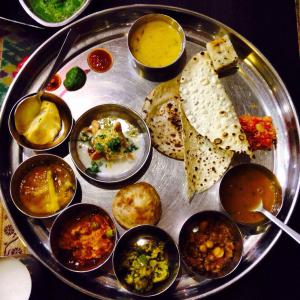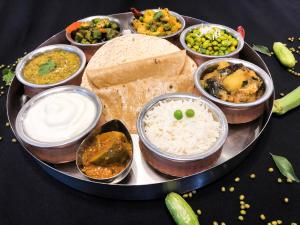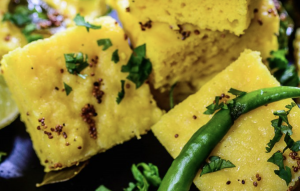
What Is Homestyle Indian Food?
How To Create A Homestyle Thali At Home In Las Vegas
A thali is a ubiquitous meal found in the Indian subcontinent. An instagrammable beauty, the thali is a delightful assortment of homestyle Indian food that’s wholesome and gratifying in equal measure.
Now you can create a festive, homestyle thali in Las Vegas from the comfort of your home.

What is a Thali
The name thali comes from the plate on which the food is served. Traditionally, a thali is a large, stainless steel platter dotted with small bowls brought to life with a myriad colorful dishes.
The thali way of eating is also a reminder of the importance of simplicity and humility in cooking, which is characteristic of most Indian homestyle cuisines.
Creamy lentils and fragrant basmati rice with bright vegetables and roti (flatbread) glistening with ghee (clarified butter) find their coveted spot on this over-the-top delight.
For many people in India, a thali is like coming home. It’s also a communal, working-class meal served in many small restaurants – nutritious, delicious, and inexpensive.
For first-timers, however, a thali can be a daunting experience. A sincere thali will make you wonder how you are going to finish it all.
The opulence of the thali does not stop at the food. Its splendor is in the details: thalis are usually large, round, stainless steel plates with matching silverware, bowls, and glasses. Silver thalis are reserved for use during festivals in many Indian homes. The hot, steaming, flavorful foods brimming playfully on the thali make it pleasing to the eye.
Types of Thalis
The Thali way of eating food is also prevalent in South Indian homestyle food, wherein the food is often served on an oversized banana leaf. The cuisine is different from that of Northern India, with the generous use of ingredients, such as coconut and curry leaves. Rice is the primary dish in the South, as opposed to North Indian food that favors flatbreads like rotis and paranthas.
In the northern state of Punjab, and at Gurudwaras (Sikh temples) across the world, the thali is a communal meal served one course at a time to people sitting on the floor. This is a free communal meal known as langar.
The Gujarati Thali
The two of the most popular thalis come from Gujarat and Rajasthan. Homestyle Gujarati food has a much lighter, more subtle flavor, and there is some use of jaggery, so it tends to be mildly sweet. Rajasthani Thalis, on the other hand, are spicier and more pungent with the liberal use of red spice.
In India, there are restaurants devoted to this style of food, and they only serve feast-worthy thalis.
Ayurveda and the Thali
According to the Ayurvedic food principles, each meal should comprise a balance of the six significant flavors – sweet, salty, sour, bitter, pungent, and astringent.
The homestyle Gujarati thali truly captures a delicate balance of heat, sweetness, and spice.
It is for this reason the thali is considered a nutritious, balanced meal.
This ancient meal style has become very popular and accessible in urban India.
Homestyle Thali in Las Vegas
In Las Vegas, you will find non-vegetarian, vegetarian and vegan thalis on Mint Indian Bistro‘s prix fixe menu.

Rotifix’s Build Your Own Homestyle Thali In Las Vegas
You can also order ready-to-eat rotis, puris, rice, and other accompaniments, and we will deliver them to your door. You can choose from our extensive North Indian, South Indian, and Gujarati menus as well as our appetizer menu.

Our lives are busy, and it isn’t easy to cook such a variety of dishes.
Once you have all the dishes prepared (or ordered), it’s time to start constructing the thali.
How To Compose a Homestyle Thali at Home
Depending on your dietary philosophy or just what you fancy on a particular day, you can create a non-vegetarian, vegetarian, or vegan thali. When it comes to Indian food, there are plenty of vegetarian and vegan choices. Even the non-vegetarian thalis have lentils and veggies amicably placed alongside chicken curry.
We’re creating a thali after all – and it must look colorful, adorned, alive and most of all, heterogeneous. In short, a thali should look like artwork!

Homestyle Gujarati food meets the Ayurvedic six schematic flavor guideline with precision. So let’s start with a traditional homestyle Gujarati thali, which is pure vegetarian.
For recreating a festive thali at home, you will also need a large thali/platter and several small bowls.
Appetizers
A thali is a complete meal on one plate. Therefore, even the appetizers find real estate on the thali and sit alongside the main meal.
Gujarati snacks provide a great balance of flavors and textures.
- Bhajia – Bhajia is deep-fried vegetables in a gram flour batter. They bring a crispy texture to the meal.

Homestyle Dhokla - Khamman Dhokla – Dhokla, on the other hand, is steamed and brings a spongy softness, for a textural contrast to the crispness of the bhajia or vegetable fritters.
Vegetables
These are the protagonists of the meal – usually two or three fresh vegetables, preferably one wet and one dry veggie dish. Some of the most favored Gujarati homestyle vegetarian dishes are noted below. You can pick a couple from the list.


- Tindora Batata Shaak – Tindora (Ivy Gourd) is cooked along with potatoes and spices in this Gujarati style dish.
- Undhiyu – Undhiyu is a variant that is served with puri at weddings and banquets. Again it is a mixed vegetable casserole, made with red lentils and seasoned with spices, grated coconut, and palm sugar in a mild sauce. It is garnished with chopped peanuts and toasted, grated coconut.
- Lauki Kofta – Lauki Kofta is made of deep-fried bottle gourd dumplings immersed in a spicy onion tomato gravy.
- Lilwa (fresh green peas) is a wintergreen vegetable. This Gujarati recipe combines Lilwa with traditional spices and vegetables.
- Fansi Sabzi – Fansi Sabzi is a delicious Indian curry of french beans with onion and tomato cooked in spices.
- Gujarati Kadhi – Gujarati Kadhi is a prevalent Gujarati dish made from buttermilk or dahi (yogurt) and gram flour (besan). This kadhi is lighter than its Punjabi version.
Dal/ Lentil / Beans
- Gujarati Khatti Mithi Dal (sweet and sour lentil), Gujarati Dal a.k.a Khati Mithi Dal is a healthy dish prepared from tuvar dal (pigeon pea) and many Indian spices. It is a staple homestyle meal made in every Gujarati household. It is mild, sweet, and sour compared with any other Indian dals.
- Green Moong Khichdi – Green Moong Dal khichdi is a simple one-pot dish of whole green gram dal and rice. Khichdi is wholesome and nutritious. Whole green gram legume is rich in proteins and fiber and when combined with rice as in this recipe, makes for a complete meal. This dish can be served with Papad / Yogurt.
- Chawli Nu Shaak – Chawli nu Shaak is a vegetable recipe made of fresh chawli beans (Green long Beans) cooked in spices. This curry has a strong flavor due to the inclusion of coriander seeds powder.
Roti/ Puri/ Flatbread
Roti (flatbread), made from whole-wheat flour, and laced with ghee (clarified butter), is the quintessential supporting star on a Gujarati homestyle plate. Puris are fried flatbreads.
Basmati Rice
Long-grained basmati rice keeps good company with the lentils/ dal and beans. It can be steamed or made with fried onions and cumin seeds for added flavor.
Accompaniments
No Gujarati thali is complete without accompaniments such as poppadum, pickles, salad, and sauces.
- Papad / Poppadum – a crunchy lentil wafer that can be roasted or deep-fried
- Achaar – Achaar is a catch-all term for pickles in India. Of course, these are spiced with complex flavors.
- Sambharo – Sambharo is a cooked salad made with cabbage and carrots.
- Chutneys – Various types of chutneys or sauces add more zing to the meal.
Beverages
Chaas – You need a spiced buttermilk drink to wash down the food. The herb and spice mix help you digest this enormous meal.
You can cook these dishes or order them from Rotifix. You can also cook a few and order others and save time, yet create a festive, artful thali that deserves accolades from family and guests alike.
Don’t forget to document your efforts by taking a picture of your thali. Better still, post it on Instagram and tag us. If you have more ideas on how to create a perfect thali, we would love to hear from you!
